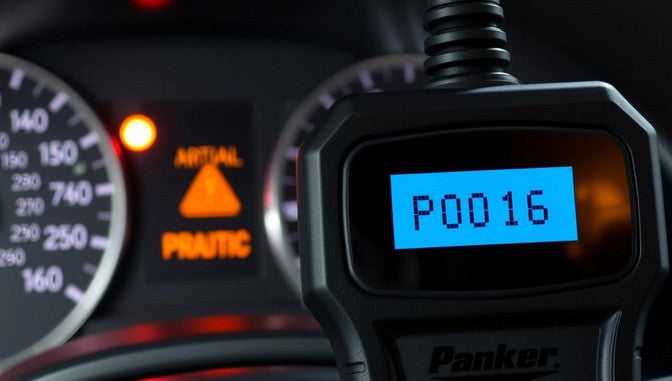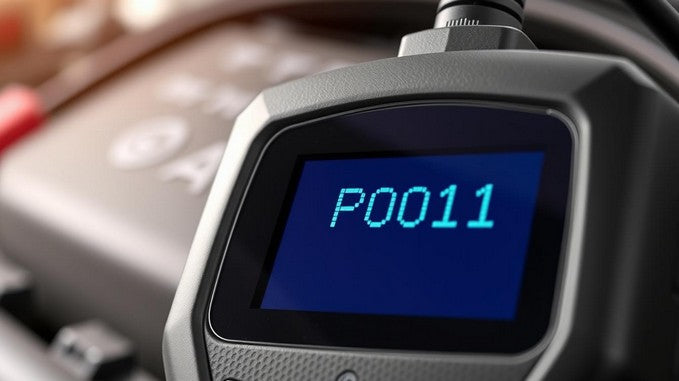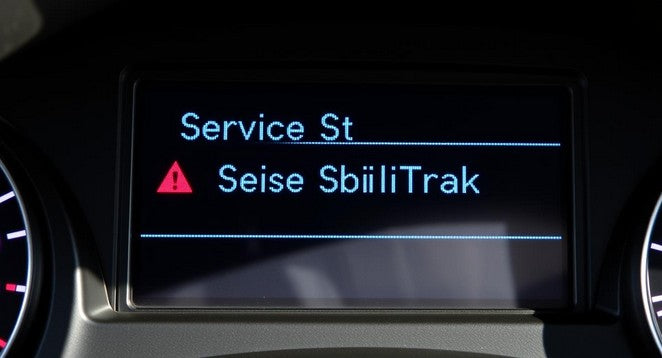When your vehicle's check engine light illuminates and a scan reveals the P0016 code, you're facing a critical timing synchronization issue between your engine's camshaft and crankshaft. This comprehensive guide explains what the P0016 camshaft position sensor code means, how to diagnose it properly, and the steps needed to fix it. Whether you're a DIY mechanic or just want to understand what your mechanic will be doing, we'll walk you through everything you need to know about this common but potentially serious engine code.
What Does the P0016 Code Mean?
The P0016 code specifically stands for "Crankshaft Position - Camshaft Position Correlation (Bank 1 Sensor A)." This generic diagnostic trouble code indicates that the Engine Control Module (ECM) has detected that the timing between your engine's crankshaft and camshaft is not synchronized as it should be. In properly functioning engines, these two components must maintain precise timing for optimal combustion and performance.
When the P0016 code appears, it means the camshaft position sensor and crankshaft position sensor are reporting a timing discrepancy that exceeds the manufacturer's specifications. This timing issue can significantly impact engine performance and potentially cause damage if not addressed promptly.
|
Code Component |
Description |
|
P |
Powertrain - Related to engine, transmission, and associated systems |
|
0 |
Generic code (common across manufacturers) |
|
0 |
Fuel and air metering |
|
1 |
Fuel and air metering (auxiliary emission controls) |
|
6 |
Camshaft/crankshaft timing issue |
Common Causes of the P0016 Code
Several issues can trigger the P0016 camshaft position sensor code. Understanding these potential causes is crucial for accurate diagnosis and effective repairs:
Timing Chain/Belt Issues
- Stretched or worn timing chain
- Jumped timing (skipped teeth on sprockets)
- Broken or damaged timing belt
- Worn timing chain guides or tensioners
- Improperly installed timing components
Sensor-Related Problems
- Faulty camshaft position sensor
- Damaged crankshaft position sensor
- Loose or corroded sensor connections
- Damaged wiring harness to sensors
- Sensor circuit issues
Oil-Related Problems
In vehicles with Variable Valve Timing (VVT), oil-related issues can also trigger the P0016 code:
- Low engine oil level affecting VVT operation
- Dirty or contaminated oil restricting oil flow
- Clogged oil passages to VVT components
- Faulty VVT solenoids or actuators
- Incorrect oil viscosity affecting VVT performance
Need a Reliable OBD-II Scanner?
Diagnose your P0016 code and other engine issues with a professional-grade OBD-II scanner. Get accurate readings and clear explanations of fault codes.
Symptoms of the P0016 Camshaft Position Sensor Code
When your vehicle develops a P0016 code, you may notice several symptoms that indicate timing issues between the camshaft and crankshaft. Being aware of these symptoms can help you identify the problem early:
|
Symptom |
Gasoline Engines |
Diesel Engines |
|
Check Engine Light |
Always illuminated |
Always illuminated |
|
Engine Performance |
Significant power loss |
Moderate to severe power loss |
|
Starting Issues |
Hard starting or no-start |
Extended cranking, hard start |
|
Idle Quality |
Rough, unstable idle |
Rough idle with vibration |
|
Fuel Economy |
Significantly reduced |
Moderately reduced |
|
Engine Noise |
Rattling, ticking sounds |
Knocking, increased noise |
Important: If you experience severe symptoms like engine stalling, excessive noise, or vibration, stop driving immediately. Continuing to drive with severe timing issues can cause catastrophic engine damage.
Step-by-Step Diagnostic Process
Diagnosing the P0016 code requires a systematic approach to identify the root cause. Follow these steps to properly diagnose the issue:
1. Initial Scan and Code Verification
Begin by connecting an OBD-II scanner to your vehicle's diagnostic port to confirm the P0016 code and check for any additional related codes that might provide more context.
2. Visual Inspection
Perform a thorough visual inspection of the timing components and sensors:
- Check for oil leaks around the timing cover
- Inspect sensor connectors for damage or corrosion
- Look for damaged wiring harnesses
- Check engine oil level and condition
- Inspect accessible timing components for obvious damage
3. Testing the Camshaft Position Sensor
The camshaft position sensor is often a primary suspect when dealing with the P0016 code:
- Locate the camshaft position sensor (typically near the cylinder head)
- Disconnect the sensor and inspect for damage or oil contamination
- Check resistance values using a multimeter (compare to specifications)
- Test the sensor circuit for continuity and proper voltage
4. Testing the Crankshaft Position Sensor
Similarly, the crankshaft position sensor should be tested:
- Locate the crankshaft position sensor (typically near the crankshaft pulley)
- Disconnect and inspect for physical damage
- Test resistance values with a multimeter
- Check the sensor circuit for proper voltage and ground
5. Timing Component Inspection
If sensor tests don't reveal the issue, inspect the timing components:
- Remove timing cover to access the timing chain/belt
- Check for proper alignment of timing marks
- Inspect the timing chain for stretching or damage
- Examine tensioners and guides for wear or failure
- Verify camshaft and crankshaft sprocket condition
Need Professional Diagnosis?
Diagnosing timing issues can be complex. Our certified mechanics have the tools and expertise to accurately diagnose your P0016 code and recommend the right repairs.
Repair Procedures for P0016 Code
Once you've diagnosed the root cause of the P0016 code, you can proceed with the appropriate repair. Here are the most common repair procedures:
Replacing the Camshaft Position Sensor
If your diagnosis indicates a faulty camshaft position sensor:
- Disconnect the vehicle's battery
- Locate the camshaft position sensor
- Unplug the electrical connector
- Remove the mounting bolt and extract the sensor
- Install the new sensor and secure with the mounting bolt
- Reconnect the electrical connector and battery
- Clear the fault codes and test drive
Replacing the Crankshaft Position Sensor
For a faulty crankshaft position sensor:
- Disconnect the battery
- Locate the crankshaft position sensor (often near the crankshaft pulley)
- Disconnect the electrical connector
- Remove the mounting bolt and extract the sensor
- Install the new sensor and secure it
- Reconnect the electrical connector and battery
- Clear the fault codes and verify the repair
Timing Chain/Belt Replacement
If the timing components are the issue, a more involved repair is necessary:
Warning: Timing chain/belt replacement is a complex procedure that requires special tools and precise measurements. Incorrect installation can cause severe engine damage. Consider professional assistance if you're not experienced with this repair.
General steps include:
- Disconnect the battery
- Remove necessary components to access the timing cover
- Remove the timing cover
- Align the engine to Top Dead Center (TDC)
- Mark or note all timing positions
- Remove the old timing chain/belt and related components
- Install the new timing chain/belt, ensuring proper alignment
- Replace tensioners, guides, and other worn components
- Verify timing marks are correctly aligned
- Reassemble all components
- Clear fault codes and test drive
VVT System Repairs
For vehicles with Variable Valve Timing issues:
- Replace faulty VVT solenoids
- Clean oil passages to VVT components
- Replace oil control valves if necessary
- Perform an oil change with manufacturer-recommended oil
Technical Specifications for Common Vehicles with P0016 Issues
Different vehicles have varying specifications for timing components and sensors. Here are specifications for some vehicles commonly affected by the P0016 code:
|
Vehicle Make/Model |
Common Cause |
Sensor Resistance Specs |
Timing Component |
Repair Complexity |
|
BMW N47 2.0 Diesel |
Timing chain stretch |
200-900 Ohms |
Chain |
High (engine removal) |
|
Chevrolet Cruze 1.4T |
Stretched timing chain |
500-900 Ohms |
Chain |
Medium |
|
Hyundai Elantra |
Oil Control Valve |
350-750 Ohms |
Chain |
Medium |
|
VW/Audi 2.0 TSI |
Tensioner failure |
300-800 Ohms |
Chain |
Medium-High |
|
Mercedes 2.1 Diesel |
Sensor failure |
400-850 Ohms |
Chain |
Medium |
|
Ford EcoBoost |
VVT phaser issues |
300-700 Ohms |
Chain |
Medium |
Prevention Tips and Maintenance
Preventing the P0016 code is more cost-effective than repairing it. Follow these maintenance tips to reduce the risk of timing-related issues:
Regular Oil Maintenance
- Change oil at recommended intervals
- Use manufacturer-specified oil grade and viscosity
- Maintain proper oil level
- Consider more frequent changes for severe driving conditions
Timing Component Maintenance
- Replace timing belts at recommended intervals
- Inspect timing chains during regular service
- Replace tensioners and guides when replacing timing components
- Listen for unusual timing chain noise
Pro Tip: Many vehicles with timing chains don't specify a replacement interval. However, having your timing chain inspected every 80,000-100,000 miles can help catch issues before they cause the P0016 code or more serious damage.
Frequently Asked Questions
How much does it cost to fix a P0016 code?
Repair costs for the P0016 code vary significantly depending on the cause and vehicle:
- Sensor replacement: $150-$400 including parts and labor
- Timing chain/belt replacement: $500-$1,500 for most vehicles
- Complex timing chain repairs: $1,500-$3,000+ for vehicles requiring engine removal (like BMW N47 engines)
- VVT component repairs: $300-$800 depending on accessibility
Costs can be higher for luxury or European vehicles due to parts pricing and labor complexity.
Is it safe to drive with a P0016 code?
Driving with a P0016 code is not recommended. The timing discrepancy between the camshaft and crankshaft can cause:
- Poor engine performance and fuel economy
- Potential for misfires that could damage catalytic converters
- Risk of complete timing failure, which could cause catastrophic engine damage
- In interference engines, valve-to-piston contact if timing fails completely
If you must drive to a repair facility, drive gently and avoid high RPMs or heavy loads. For severe symptoms (stalling, loud noises), towing is recommended.
Can a P0016 code clear itself?
While the check engine light and P0016 code might occasionally clear themselves temporarily, this doesn't mean the underlying issue is resolved. This can happen if:
- The timing temporarily returns to acceptable parameters
- The battery is disconnected, resetting the ECM
- The vehicle completes several drive cycles without detecting the issue
However, if the root cause (worn timing components, faulty sensors) isn't fixed, the code will almost certainly return. Temporary disappearance of the code should not be interpreted as a successful repair.
Conclusion
The P0016 camshaft position sensor code indicates a critical timing issue that requires prompt attention. By understanding the causes, symptoms, and repair procedures outlined in this guide, you can make informed decisions about addressing this problem. Whether you choose to tackle the repairs yourself or seek professional assistance, addressing the P0016 code quickly will help prevent more serious engine damage and restore your vehicle's performance.
Remember that proper maintenance, especially regular oil changes and timing component inspections, is the best way to prevent timing-related issues from occurring in the first place. If you're experiencing symptoms of the P0016 code, don't delay in diagnosing and repairing the problem.




Leave a comment
This site is protected by hCaptcha and the hCaptcha Privacy Policy and Terms of Service apply.